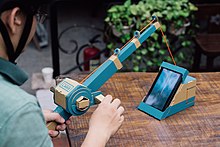Nintendo Labo
Players may freely decorate the cardboard parts using coloring pens, tape, and other materials, while more experienced users can invent new ways to play with each Toy-Con.
[5] Replacement packs for individual parts and Toy-Con are available for purchase on Nintendo's online store,[6][7] while free templates for the cardboard cut-outs are also available for download.
[15][16] Labo developers stated in an interview that the original prototype was a ground-based tank with interactive floor pedals, but risked being crushed by the user and did not utilize the potential of the Joy-Con's gyro sensor; to solve these issues, the prototype was modified to be worn as a "Carry-Con" on the user's back.
The Vehicle Kit includes the cardboard parts to make three steering consoles, one for a car, one for a plane, and one for a submarine, each with a slot for a "key" that is built around a Toy-Con.
The main kit comes with parts to make five items, each of which can be attached to the VR Goggles: a Blaster, a camera, a bird, an elephant head, and a pinwheel.
Following the release of Nintendo Labo, select software titles have received free updates giving them compatibility with certain Toy-Con.
A free update to Mario Kart 8 Deluxe in June 2018 allowed players to use the motorbike Toy-Con, from the Variety Kit, to control their racer in the game.
[22] In August 2018, Nintendo announced that the car steering wheel Toy-Con from the upcoming Vehicle Kit will also be compatible with Mario Kart 8 Deluxe.
[23] After unveiling a tech demo in April 2018,[24] in August 2018, Rayark announced that it would add a mode to its piano-based rhythm game Deemo in October 2018 to support the piano Toy-Con on selected songs, as the first third-party title to offer integration with one.
[42] As the Labo concept was developed, they found it fit well within Nintendo's overall philosophy on innovating new ways to have fun, and had potential to introduce the Switch to more than just game enthusiasts.
The Joy-Con were treated as a "bundle of sensors" that could be used in a multitude of ways by attaching them to different hardware pieces, focusing on the gyro motion-sensor, IR motion camera, and HD Rumble features.
Improvements were made to the prototypes based on feedback from consumer and developer testing; this prompted the creation of the interactive instruction software, as well as favoring simplicity over appearance.
[2][6][7] When asked about the durability of Labo during an interview with CNET, Yoshiyasu Ogasawara stated, "We tested their resilience to the same action through hundreds and thousands of repetitions, so we expect them to last a long time under normal use.
Analysis suggested that Labo was the type of unorthodox product that only Nintendo could develop and market, showing a further return to their more financially successful period about a decade prior, leading to the rising stock price.
[49] Nintendo Labo was received with praise for its unique take on video gaming and unconventional method of play,[50][51] and its ability to encourage creativity and learning, especially in children.
[53][52] Reviewers were mixed on the enjoyment and limited replay value of the software's gameplay,[50][54] with Andrew Webster from The Verge saying "the games are perhaps the least interesting part of Labo.
"[53] However, critics highlighted the seemingly unlimited options provided by Toy-Con Garage, and the possibility for the community to develop and share new creations.
[56][57] The Verge and CNET found Labo to be a clever utilization of the Joy-Con controllers' motion sensors, HD Rumble, and IR sensing abilities.



